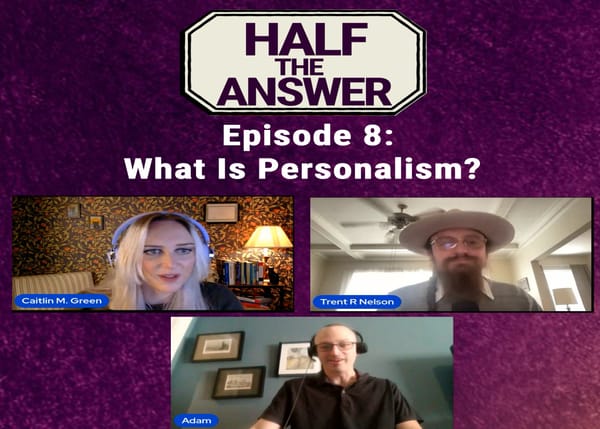DeSantis's Nazi Problem and the Republican Staffer Class

The latest person touted as national conservatism’s trendy intellectual is more than a little sympathetic to fascism—quelle surprise. Former DeSantis staffer Nate Hochman has joined Pedro Gonzalez as another DeSantis orbiter unable to stay off the third rail of modern conservative politics: being an (open) fascist.
Gonzalez, an editor of the paleoconservative mag Chronicles and verbose DeSantis defender, had his antisemitic messages leaked to Breitbart during an internecine conservative spat. Of course, one can only be but so surprised when a paleocon’s racism goes from implicit to explicit. Hochman on the other hand was the beau ideal of the supposedly intellectual right, a self-admitted beneficiary of the gracious “conservative welfare state.” He bounced between internships and fellowships at AEI, National Review, the Claremont Institute, and the Intercollegiate Studies Institute before landing a cushy gig as a National Review staff writer—a real prestigious who’s who tour of billionaire apologia.
Hochman was hired from National Review to be a speechwriter for the DeSantis presidential campaign. One imagines Hochman probably saw his shot at being the DeSantis White House’s Karl Hess or Pat Buchanan (a fitting comparison in more ways than one) and took it.
On July 23, the pseudonymous Ron DeSantis Fancams Twitter account (@desantiscams) posted one more in a steady stream of DeSantis video edits. The first minute of the video is only as disgusting as the standard conservative propaganda: criticizing Trump’s failure to build the border wall, his promotion of the COVID-19 vaccines, and his brief acceptance of LGBTQ voters back in 2016. For the last eight seconds of the video, though, the camera zooms into a spinning red Sonnenrad while men with rifles march onward, all set to Kate Bush (one wonders what she did to deserve this). Originally commissioned by Heinrich Himmler, for decades the Sonnenrad has been the design of choice for the neo-Nazi who thinks the swastika is a bit too gauche.
Following initial reporting that the video was deleted after a DeSantis staffer had retweeted it, Hochman was identified as the culprit almost immediately. On July 25th, news broke that the DeSantis campaign had been clearing house, firing over 40% of its staff. And later that day, Axios reported that Hochman had both been a member of that 40% and had likely made the video himself. DeSantis’ wunderkind speechwriter was caught dreaming about DeSantis leading an American fascism and got fired. A rather rapid fall from grace for someone who’d had a fawning profile in The New Republic.
Stepping back from all of this, the astute follower of politics should be wondering why everyone acted like they were so surprised by Hochman’s fascist turn. How many laudatory profiles of antisemites and Twitter Spaces with Holocaust deniers (conducted before Hochman was hired by the DeSantis campaign!) does it take for conservatives to start asking the obvious questions?
Semafor has now reported that Hochman’s video, the earlier video favorably comparing DeSantis to fictional serial killer Patrick Bateman, and many similar fancams were cooked (and hyped) up in a Signal chat filled with DeSantis staffers. In leaked screenshots of the chat, DeSantis campaign research and data director Kyle Lamb notably said Hochman’s Sonnenrad video “belonged in the Smithsonian.” Hochman and Lamb have both been let go but other members of the groupchat, including rapid response director Christina Pushaw, are still employed by the campaign.
Between Gonzalez and Hochman, and the host of DeSantis campaign staffers retweeting these videos and in that Signal chat, it’s not hard to identify the pattern. They might all be trying to get DeSantis elected president, but they’re pretty clearly dreaming of getting him appointed führer.
To understand why, it’s important to note that when young conservatives first glommed onto DeSantis like so many remoras, DeSantis was winning. Some of Hochman and Gonzalez’ first DeSantis puff pieces were about DeSantis passing legislation to protect “parental rights” and to crack down on Disney for “grooming” children. As proper conservative intellectuals, they obviously recognized that children aren’t just born queer. It has to be those evil, conniving teachers and the leftist executives at Disney forcing them into the lifestyle. Luckily, here comes Governor DeSantis to crack down on degeneracy and actually pass some laws.
John Ganz writes that “[f]ascist politics give the feeling of ‘momentum,’ ‘going there’ and ‘moving towards,’ an exciting sense of fatal direction.” In contrast, one of Hochman’s favorite philosophers, the genuinely brilliant Michael Oakeshott, wrote that conservatism is defined by “a propensity to use and to enjoy what is available rather than to wish for or to look for something else; to delight in what is present rather than what was or what may be.”
Oakeshottian politics is a politics of contentment and of human limits, a politics of remaining still. In a word, boring. In his column reflecting on the 30th anniversary of Oakeshott’s death, Hochman wrote that “it is often difficult to translate this ‘conservative disposition,’ as Oakeshott described it, into a political program.” Whittaker Chambers struggled with this translation as well, writing that “a conservatism that cannot face the facts of the machine and mass production, and its consequences in government and politics, is foredoomed to futility and petulance” (Odyssey of a Friend, 79).
Conservatism has long since cleared the hurdles Chambers feared, but it’s still wrestling with the realities of the internet. Able to escape the strictures of local prejudices, companies in a national market find it profitable to accept and cater to LGBTQ customers, employees, and celebrities. ESG and DEI initiatives become commonplace not because of the machinations of the dreaded professional managerial class (PMC), but because they’re cheap ways to expand customer bases, attract investment, and retain employees.
Faced with the transformation of society by mass production, Chambers retreated to a farm in rural Maryland. The modern right’s total rejection of this strategy of retreat and isolation is exemplified by Rod Dreher. Author of The Benedict Option, a call for American Christians to retreat to localist communes, Dreher now lives in Hungary, extolling the benefits of Orbán’s militant illiberalism. The focus has shifted from Christians living good lives by distancing themselves from debased, secular politics to “co-opt[ing] and transform[ing] the decaying regime from within its own core.”
While Chambers and Oakeshott lamented capitalism’s effects on society, modern conservatives have become aspiring Luddites. They find their “sense of fatal direction” in the urge to raze purportedly liberal institutions and return the world to an idealized Bronze Age by force. Instead of facing the facts of the machine and mass production (now the internet and social media), they plot to smash the machine. The remnants of fusionism standing in the way of this urge to destroy, like any attachment to free markets, are to be summarily discarded.
Governor DeSantis’ fundamental pitch to voters and to donors is that he could deliver a “competent Trumpism,” using his understanding of the levers of power to win both the trade wars and the culture wars. Candidate and President Trump promised both psychic absolution and social status to his supporters—“Make America Great Again” contains both the assurance that the past wasn’t that bad, really, and the promise that life will soon be better.
When promising to actually deliver on Trumpism, the DeSantis campaign pitches a conservative utopia: a world with no queer people, no feminists, no anti-racists, and no socialists where every (white) person lives in a nice single family home with a picket fence and a Golden retriever. The most basic examples of recognizing that minorities suffered under this ancien regime they seek to restore become unacceptable, and every cultural grievance can now be solved by using state power. As DeSantis crows, even creating “a family-focused economy means having the courage to take on our enemies [emphasis added].”
The DeSantis campaign is best characterized by their desire to act upon a world seen as degenerate, a perverse delight in what was and what may, can, will be again rather than what is present. Potentially salutary conservative impulses fuel instead a nihilistic myopia. In Hochman’s first post-firing column (now retracted by The Telegraph), he argues Trump being prosecuted while Biden walks free reflects “the republic’s crumbling constitutional architecture” while completely ignoring Trump’s attempt to destroy that same architecture. The column’s title exemplifies the blend of revanchism and apocalypticism now typical of modern conservative thought: “Republicans must fight dirty – or America is finished.”
Like George Wallace voters in ’68, many conservatives now “[feel] that ‘the system is breaking down’ … that the citizen [is] alone and vulnerable, of no concern to the courts, the pointyheads, the diplomats. So throw them out, with their bicycles, briefcases, umbrellas. Tear them down” (Nixon Agonistes, 36). DeSantis supporters by and large are DeSantis supporters because they gravitated to the candidate who seemed the most able, the most likely to prosecute their grievances and their neuroses. We shouldn’t be surprised that they have begun to look at the authoritarians and fascists of the past and see models, not warnings.
Featured Image is Charlie Kirk and Ron DeSantis, by Gage Skidmore




